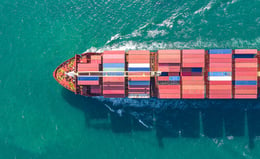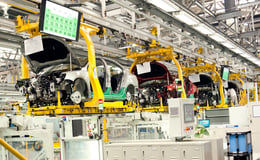5 Causes of Bottlenecks in the Global Supply Chain
Brian Hoey - May 21, 2020

Let’s say you’re cooking up a big family meal, and you’re trying to estimate how soon the food will be ready. You look at the recipe, and you add up the cooking times for various elements, plus all of the time it takes to prepare the ingredients. You estimate that the meal should take you about an hour. Two hours later, you find that you’re still cooking, and your kids are starting to get grumpy while they wait. What happened?
Possibly, your estimate didn’t account for the bottlenecks you inevitably ran into. Maybe you can’t chop vegetables as quickly as the recipe expects you to because your knife hasn’t been sharpened recently, meaning that the entire process was delayed before any real “cooking” began. Maybe you were working with a stove that only had two burners, meaning that you couldn’t sauté your vegetables, make a roux, and simmer your sauce at the same time. Or maybe you simply didn’t have enough pots, pans, and cutting boards for the project, so you had to stop and clean up multiple times in the middle of the process. At the end of the day, these various bottlenecks were able to accumulate, and the result was a significant delay.
As it is with cooking, so too is it with the global supply chain. Instead of being too slow to chop veggies or having too little equipment, you might be dealing with disorganized inventory or siloized route planning—but the effect is the same: you need to find those bottlenecks and root them out.
1. Single-Sourcing
When you encounter supply chain delays, bottlenecks (rather than one-time disruptions like weather or traffic events) are often the root cause. The key to dealing with those bottlenecks? Understanding their root causes. For instance, in the midst of considerable supply chain turbulence around the world, numerous manufacturers and other supply chain players are realizing that single-sourcing (e.g. relying heavily on just one supplier) can increase the risk of bottlenecks. If, for instance, your sole supplier for a particular part or raw materials is in a country that’s locked down by a pandemic, your production programs may grind to a halt because you simply no longer have the materials on hand to complete production runs. The antidote here is obviously to find new businesses to source from—but the ideal time to do so is before a disruption like this emerges, rather than after.
2. Planning Silos
In our cooking example, one of the ways that bottlenecks were able to emerge was from a lack of planning clarity—you looked at the recipe, but you didn’t necessarily go through every step of your food production plan to uncover potential pitfalls. Or, maybe you started chopping vegetables only to realize that your spouse was already using the oven for a loaf of bread. In an industrial context, the same concerns apply: you need to make sure that your plans square both with reality and with the plans of others up and down the value chain. If you’re plotting out a production run in a job shop based on materials you expect to have in your buffer stock at the same time that, unbeknownst to you, your inventory planners are working to go lean and eliminate most of that buffer stock, you’re in for a catastrophic production run that will waste capacity at best and costly raw materials at worst while you wait for your inventory planners to restock to the necessary levels. The best way to avoid this kind of unnecessary waiting is to make sure that every touchpoint has insight into the planning protocols of every other touch point. How do you do that? Integration.
3. Poor Technology Integration
As it happens, poor technology integration is a cause of bottlenecks in and of itself—though of course it’s a critical factor in planning silos as well. Let’s say you’ve got three suppliers for a key raw material that goes in your production programs: With one of these suppliers, you share some IT infrastructure, such that you can get a window in their supply in real time, whereas with the other two you’re flying blind. Where do you most expect bottlenecks to crop up? That’s right, with the two that don’t boast any integration whatsoever. Why? Because you could easily find that lead times for orders had expanded without any notice, and your machine would have to sit idle while you waited for parts, resulting in a ripple effect far upstream in your operations.
4. Low Visibility
Sensing a theme here? Just as poor integration breeds planning silos, it also creates low visibility—which is another leading cause of bottlenecks. Let’s think about our cooking experiment again: If you have an overview of the entire process and all of the materials used therein, it’s easy enough to notice the parts of the process where you’re slowing down or getting held up. Without all of that insight, however, you might be unable to figure out exactly what’s going wrong. Given the incredibly complexity of the modern global supply chain, figuring out the cause of any recurring disruptions isn’t as simple as counting up pots and pans—on the contrary, it often require you to have insight into every touchpoint on the value chain, with a live view of your inventory, your logistics operations, your bills of materials for production, and much more. If you can’t do that, the bottlenecks will proliferate and they will eat into your profits considerably.
5. Lack of Planning
Above, we said that planning silos could be a major cause of disruption and delay. This is undoubtedly true—at the same time, not having a plan in the first place can be just as problematic. Let’s take S&OP (sales and operations planning) as an example: Without a corporate plan for meeting demand over the next 12-18 months, how are planners in disparate departments going to align with one another? That's right: they’re probably not. As a result, every department will find its plans slowed down by every other department, since they’re all working at cross purposes. At the end of the day, it’s critical not just to have a strong, data-driven planning workflow that uncovers potential bottlenecks and addresses them proactively, it’s also important to do so in a way that’s eminently flexible. Rather than improvising when things go sideways, you want to be able to perform smart re-plannings on a moment’s notice. In this way, you can begin to work toward more optimal supply chain functionality.
If you want to learn more, download your guide to Transformation of Manufacturing Processes.
In this Guide you will learn:
-
Emerging Challenges in the Modern Truck/Automotive Industry
-
How Can Global Companies Adapt to These New Realities
-
How Decentralized Digital Systems Power Smarter Planning Processes
-
How flexis Can Support Flexible Supply Chain Transformation
LATEST POSTS
- Understand Circular Economy in The Manufacturing Industry
- How Can Industry 4.0 IT Integration Be Achieved Smoothly?
- The Significance of Order Sequencing in Discrete Manufacturing
- How to improve your Supply Chain Management: The Power of Control Towers
- Optimizing Human Resource Scheduling in Manufacturing: A Technological Approach



